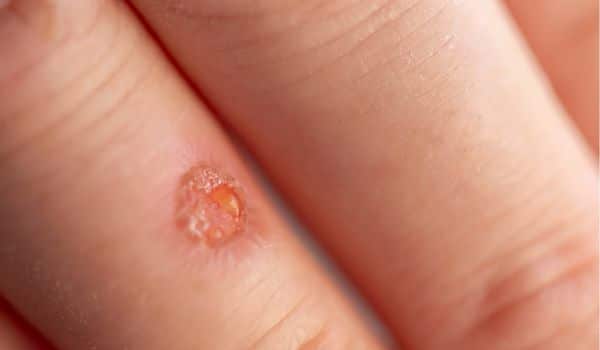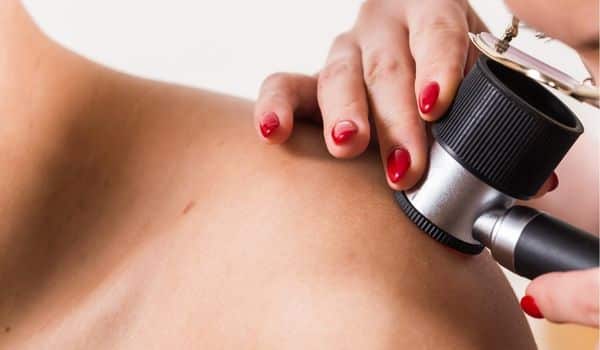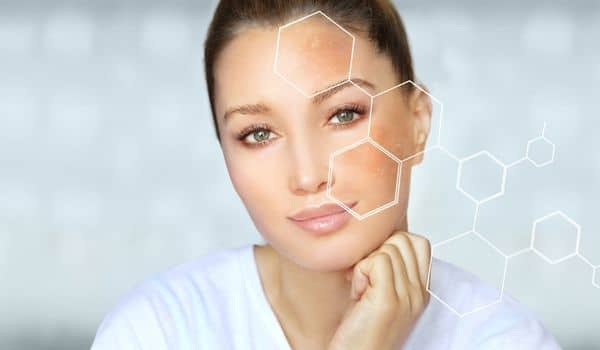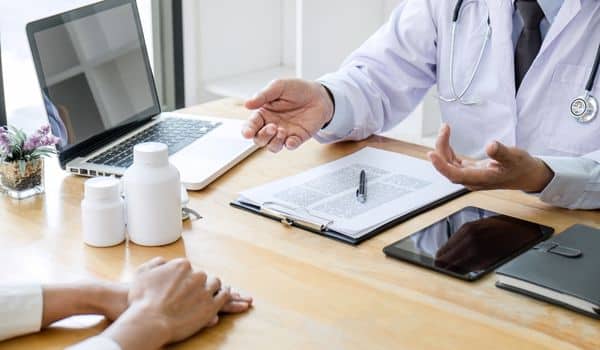Skin Lesion & Malignant Skin Lesion Treatment NZ by Dr Gittos
A skin lesion is an abnormal lump, bump or crack on your skin. This skin condition may be benign (non-cancerous) or malignant (cancerous).
The lesion can occur anywhere on your body and can vary in colour. Aside from being a cosmetic concern, you might need to get the lesion removed as a form of treatment or for diagnostic purposes.
Dr Mark Gittos is a specialist plastic surgeon based in Auckland with other clinics around New Zealand and UK. With years of experience, Dr Gittos can safely remove your skin lesion and give you a better aesthetic result.
Diagnosis of a Skin Lesion

It is important to differentiate between a cancerous and non-cancerous lesion to create the best treatment plan. In order to diagnose a lesion, your skin doctor will conduct a full physical examination. This includes a simple inspection and palpation of the lesion and removal of a sample tissue from the lesion for observation under a microscope (biopsy).
Your doctor can also take a swab from the lesion to send to a laboratory.
Different Treatments for a Skin Lesion
There are several ways to treat lesions including the following:
Medication: you can use creams, ointments, or lotions to help address the inflammation and protect the affected area. These medications can also help achieve relief from discomforts such as pain, burning, or itching caused by the lesion.
Examples of medications for skin lesions are corticosteroids, antimicrobial agents, antiviral agents, or retinoid
Surgery: there are different ways to perform the surgical procedure.
For infected skin lesions, they are typically pierced and drained. Some types of lesions with malformed blood vessels may require laser surgery.
For suspicious-looking lesions that have been changing over time, Dr Gittos will first mark out the area on the skin. A local anaesthetic will be then injected to minimise discomfort. Once the area is numb, the lesion and a margin of healthy tissue around the skin lesion are removed to ensure that no malignant tissue is left behind. Depending on the complexity of the procedure, the wound can be closed by using stitches, transferring skin adjacent to the wound (flap procedure), or transferring skin from a distant site (graft procedure). The entire procedure may take 20 to 30 minutes to complete.
What to Expect after Skin Lesion Removal
After the procedure, you may experience mild pain or discomfort once the anaesthesia wears off. Dr Gittos can prescribe pain medications, antibiotics, and anti-inflammatories. In the first 2 weeks after skin lesion removal, swelling and bruising are normal and will just resolve over time.
To ensure proper healing, a padded bandage may be placed over the wound. Sutures may need to be removed after 5 to 7 days and the pack may be removed after 10 to 14 days. Before you go home after your surgery, you will receive specific instructions from Dr Gittos regarding wound care and follow-up.
Risks and Complications of Skin Lesion Removal
Like any other surgical procedure, lesion removal has risks and complications. Having a complication depends mainly on factors such as whether you smoke, your overall health status, your post op care and how your body heals. The Risks and complications associated with lesion removal are the following:
- Allergic reaction to the equipment, materials, or medication
- Bleeding
- Blisters and ulcers
- Changes in skin colour
- Changes in skin sensation
- Delayed wound healing
- Infection
- Nerve damage
- Pain
- Poor cosmetic results
- Recurrence of the lesion
- Scars (keloids)
- Wound breakdown
FAQs about Skin Lesions and Skin Lesion Removal

What does a skin lesion look like?
- Skin lesions are areas of skin that look different from the normal skin or surrounding area. They can appear as bumps or patches and can be caused by a broad range of factors. Skin lesions are described as an abnormal bump, lump, sore, ulcer, or coloured area of your skin. In most cases, skin lesions are harmless or benign but some can increase your risk of skin cancer.
What are the types of skin lesion?
- There are 2 types of skin lesions:
- Primary skin lesions: these are abnormal skin conditions that occur at birth or are acquired at a later stage in life. Primary skin lesions are divided into three groups such as lesions formed by fluid within the skin layers, lesions that are solid masses, and flat lesions
- Secondary skin lesions: these lesions develop when primary skin lesions are irritated or manipulated. The primary skin lesions can also change over time and develop into secondary skin lesions
What are the 6 primary skin lesions?
The 6 primary skin lesions are the following:
- Macule: a distinct skin discolouration that appears flat and has a diameter of less than 1 centimetre. A macule does not cause changes in the texture or thickness of the skin
- Papule: it is an elevated skin area with no fluid. A papule has a diameter of less than 1 centimetre and comes in a variety of shapes but has distinct borders
- Nodule: a nodule is characterised by a raised bump on the skin that has a diameter larger than 1 centimetre. It may develop in all skin layers such as the dermis, epidermis, and subcutaneous tissue (under the skin)
- Tumour: it is a solid mass on the skin or under the skin and has a diameter greater than 2 centimetres. A tumour may be benign or malignant (cancerous)
- Plaque: it appears as a flat-topped, elevated lesion with a diameter greater than 1 centimetre. A plaque can be reddish, itchy, or scaly and can be found in different body areas
- Vesicle: it is an elevated bump filled with air or clear liquid and has a diameter of less than 1 centimetre
What are the main causes of a skin lesion?
Skin lesions can be caused by a broad range of factors such as:
- Genetics: skin lesions can be passed down by the parents to their children
- Infections: viruses such as herpes simplex, human immunodeficiency virus (HIV), or human papillomavirus (HPV) can cause various lesions to occur
- Allergic reactions: hypersensitivity reactions to medications or allergens can cause skin lesions
- Certain medications: skin lesions can develop as a side effect of medications such as corticosteroids or anti-cancer medications
- Prolonged sun exposure: the ultraviolet light from the sun can cause sunburns and cancerous lesions
- Vitamin B12 deficiency: this can cause skin hyperpigmentation (darker skin patches), vitiligo (pale white patches), and inflammatory skin conditions
What are the common cancerous skin lesions?
The following are the most common malignant tumours:
- Basal-cell carcinoma or BCC(a bump that’s skin-coloured or pink and occurs due to sun damage)
- Squamous-cell carcinoma or SCC (thin, flat lesions that look like fish scales and are also caused by sun damage)
- Malignant melanoma (the most serious type of skin cancer that develops in the cells that produce the pigment melanin)

What do benign lesions look like?
Unlike malignant or cancerous lesions, benign skin lesions have the following characteristics:
- Grow slowly over time
- Have a uniform appearance
- Stable
- Symmetrical
- Well-circumscribed
However, it can be challenging to identify benign and malignant lesions. In this case, a biopsy is performed to determine if the lesion is cancerous or not.
What is a papule?
- A papule is an elevated skin area with no fluid. A papule has a diameter of less than 1 centimetre and comes in a variety of shapes but has distinct borders.
What is an example of a lesion?
- The best known examples of lesions are acne, blisters, blackheads, whiteheads, cold sores, freckles, hives, keloids, moles, cysts, skin tags, and warts.
How do you get rid of a non-cancerous skin lesion?
- Simple treatments for these lesions are creams, ointments, or lotions. These medications can help relieve inflammation and discomforts such as pain, burning, or itching caused by the skin lesion. For skin lesions that cannot be treated with medications, surgery can be performed.
- For infected skin lesions, they are typically pierced and drained. Some types of lesions with malformed blood vessels may require laser surgery.
What does a cancerous lesion look like?
Cancerous lesions have the following characteristics:
- Asymmetrical or not uniform
- Irregular borders or shape
- Has more than one colour or shade
- Larger than 6 mm in diameter
- Often changes in size, shape, or colour
What does it mean if you have a skin lesion?
- This means that you have areas of skin that look different from the normal skin or surrounding area. They can appear as bumps or patches and can be caused by a broad range of factors.
When should I worry about a lesion?
- You should seek medical help immediately if your skin lesions are asymmetrical, have irregular borders or shape, have more than one colour or shade, are larger than 6 mm in diameter, and often changes in size, shape, or colour. These are the characteristics of cancerous skin lesions.
What should I expect during a skin consultation?

- During your consultation, Dr Gittos will ask about your complete medical history and discuss with you the details of the procedure – this includes the type of anaesthesia and downtime. Dr Gittos may also take skin lesions pictures to allow comparison once the removal is complete. In addition, you may also view different types of skin lesions chart and skin lesions on face images to gain a better understanding of the skin condition.
Where will the incisions/scars be after removal of lesions?
- This will depend upon the location of the lesions.
What type of anaesthesia will be used?
- The type of anaesthesia will depend on the size and location of the skin lesion. This will be determined during the consultation period.
Is there downtime associated with skin lesion removal?
- The downtime will vary depending upon the size and location of the skin lesion. During your initial consultation, this will be discussed along with specific aftercare instructions.
How long do the effects of skin lesion removal last?
- If your skin lesion is completely removed and there are no complications, you may need a regular yearly skin check with your general practitioner.
How do you make lesions heal faster?
To speed up your healing:
- Apply antibiotic ointment as prescribed
- Do not pull or pick the scab
- Do not use hydrogen peroxide or alcohol as they can cause skin irritation
- Examine the wound for any foreign objects and dirt
- Pat the wound dry using a clean cloth
- Remove jewellery and clothing from around the wound
- Take medications as prescribed
- Use a non-stick bandage to prevent further injury
- Use a thin layer of petroleum jelly to cover the wound
- Wash around the wound with clean water twice a day
- Wash your hands before and after performing wound care to prevent infection
How long does it take to excise a lesion?
- Most of these procedures may take 20 to 30 minutes to complete. However, complicated procedures can take a few hours.
Can I go back to my normal routine after the procedure?
- You can go back to your normal routine on the same day or the day after the procedure. However, you will need to avoid strenuous activities and contact sports to prevent further injury.
When should lesions be removed?
Your health care provider may recommend having a lesion removed if you have any of the following skin conditions:
- Actinic keratosis
- Benign growths
- Bowen disease
- Moles
- Seborrheic keratosis
- Skin tags
- Squamous cell carcinoma
- Warts
How long does it take for skin to regrow?
- After the removal of lesions, your skin may start to regrow after 28 to 42 days.
Further Reading – Medical References about Skin Lesion Removal
- Slideshow: Causes of Skin Lesions – WebMD
- What Skin Cancer & Precancerous Lesions Look Like – WebMD
- Skin lesions: Pictures, treatments, and causes
About Dr Mark Gittos FRACS (Plast) – New Zealand Plastic Surgeon
Practice locations in Herne Bay Auckland, Northland and Bay of Plenty – Kerikeri, Whangarei, New Plymouth & Tauranga
Dr Mark Gittos is a leading Specialist Plastic Surgeon and operates a practice in Herne Bay, Auckland and in the UK. The practice focuses on both surgical and non-surgical procedures, each designed to help restore, improve or change a physical characteristic or problem. The first step in every case is to talk through your personal requirements and explore all the options, before deciding on the most effective solution.
Dr Mark Gittos offers high quality, natural-looking cosmetic surgery results and is highly experienced in Breast, Body and Face Surgery having performed over 4000 Surgeries in the last 26 years. With worldwide expertise Dr Gittos is an expert in breast, face and body surgery for men & women.
Naturally, before any treatment is begun, we will explain clearly the advantages and risk factors; so that you have the information you need to make an informed decision that is best for you. Visit the practice to find out more.

NEXT STEPS
Please NOTE: Dr Gittos only performs surgery on non-smoker patients with a BMI less than 30. To check your BMI please visit the NZ Heart Foundation website. For help giving up smoking before surgery visit the Smoke Free website
Do your Research
- Read the Website and Blogs relevant to your procedure
- Browse our Frequently Asked Questions including how to choose a Surgeon for your procedure
- Download and read the FREE Guides to Surgery
What to Bring to your Plastic Surgeon Consultation
- Bring a friend or relative to help discuss the information and your choices
- Take lots of notes and read the documents provided thoroughly
- Dress in simple clothes as you may need to undress for examination
- Bring your medical referral and any relevant medical documents or test results
Book your Initial Surgery Consultation
- A Referral from your GP or specialist is helpful but NOT essential – you can have a consultation without a GP Referral
- Email us or Call on 09 529 5352 to arrange your surgeon consultation appointment.
- Book a consultation with Dr Gittos by paying the Consultation Fee – $325 incl GST
Traveling for Surgery? – Consider post-surgery luxury recovery in a Hotel with LuxeCare
Please contact us to arrange to book a consultation with our Specialist Plastic Surgeon or to speak with our Patient Care Advisor.
Send an enquiry form today or phone 09 529 5352 during Clinic Hours
